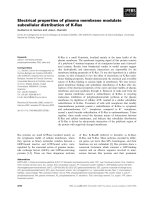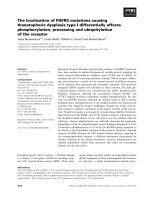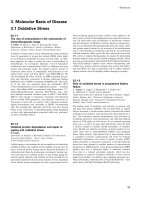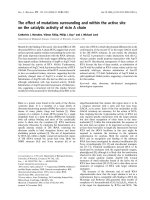Báo cáo khoa học: The properties of phosphodiesterase 11A4 GAF domains are regulated by modifications in its N-terminal domain pptx
Bạn đang xem bản rút gọn của tài liệu. Xem và tải ngay bản đầy đủ của tài liệu tại đây (189.02 KB, 8 trang )
The properties of phosphodiesterase 11A4 GAF domains
are regulated by modifications in its N-terminal domain
Marco Gross-Langenhoff
1
, Arnulf Stenzl
2
, Florian Altenberend
1
, Anita Schultz
1
and
Joachim E. Schultz
1
1 Pharmazeutisches Institut, Universita
¨
tTu
¨
bingen, Germany
2 Urologische Universita
¨
tsklinik, Universita
¨
tTu
¨
bingen, Germany
The secondary messengers cAMP and cGMP regulate
a variety of signalling pathways in essentially all cells
[1]. Their intracellular levels are balanced by the
rates of biosynthesis via adenylyl cyclase (EC 4.6.1.1)
and guanylyl cyclase (EC 4.6.1.2) and of breakdown
via cyclic nucleotide phosphodiesterase (PDEs;
EC 3.1.4.17). The human genome codes for 10 ade-
nylyl cyclase (AC) and 21 PDE genes. The latter have
been grouped into 11 families based on sequence simi-
larities [2]. This set of biosynthetic and degrading
enzymes allows precise regulation of secondary mes-
senger levels in different tissues, in individual cell types
and in different subcellular compartments. As far as
PDEs are concerned, all share a highly conserved cata-
lytic domain located C-terminally, yet show consider-
able variability in their N-terminal regions where the
regulatory domains reside [3,4]. PDE1, )2, )4, )5, )6,
)10 and )11 have an N-terminal tandem domain
arrangement, and this may exert its regulatory control
of the catalytic domains in a mechanistically similar
mode. PDE2, )5, )6, )10 and )11 have N-terminal
tandem GAF domains preceded by N-terminals of
different lengths. GAF domains are small-molecule-
binding domains that have been identified in > 3000
proteins throughout all taxonomic kingdoms [5,6]. The
acronym GAF is derived from the proteins in which
these domains were initially identified (mammalian
cGMP-binding PDEs, Anabaena adenylyl cyclases and
Keywords
adenyl cyclase; cGMP; cyclic nucleotide
phosphodiesterase 11; GAF tandem domain;
regulation
Correspondence
J. E. Schultz, Pharmazeutisches Institut,
Universita
¨
tTu
¨
bingen, Morgenstelle 8,
72076 Tu
¨
bingen, Germany
Fax: +49 7071 295952
Tel: +49 7071 2974676
E-mail:
(Received 22 October 2007, revised 4
December 2007, accepted 5 February 2008)
doi:10.1111/j.1742-4658.2008.06319.x
The tandem GAF domain of human phosphodiesterase 11A4 (hPDE11A4)
requires 72 lm cGMP for half-maximal effective concentration (EC
50
)ofa
cyanobacterial adenylyl cyclase used as a reporter enzyme. Here we exam-
ine whether modifications in the N-terminus of PDE11A4 affect cGMP sig-
nalling. The N-terminus has two phosphorylation sites for cyclic nucleotide
monophosphate-dependent protein kinases (Ser117, Ser168). Phosphoryla-
tion of both by cAMP-dependent protein kinase decreased the EC
50
value
for cGMP from 72 to 23 lm. Phosphomimetic point mutations
(S117D ⁄ S167D), which project complete phosphorylation, lowered the
EC
50
value to 16 lm. Structural and sequence data indicate that 196 amino
acids precede the start of the GAF domain in hPDE11A4. Removal of 197
amino acids yielded unregulated cyclase activity, whereas truncation by 196
amino acids resulted in a cGMP-regulated protein with a cGMP EC
50
value of 7.6 lm. Truncation by 176 amino acids was required for cGMP
EC
50
values to decrease to below 10 lm; a construct truncated by 168
amino acids had an EC
50
value of 224 lm. The decrease in EC
50
values
was accompanied by a sixfold increase in basal activity; the extent of
cGMP stimulation remained unaffected, however. We conclude that N-ter-
minal modifications strongly affect cGMP regulation of hPDE11A4.
Abbreviations
AC, adenylyl cyclase; cAK, cAMP-dependent protein kinase; cGK, cGMP-dependent protein kinase; EC
50
, half-maximal effective
concentration; hPDE11A4, human PDE11A4; PDE, cyclic nucleotide phosphodiesterase.
FEBS Journal 275 (2008) 1643–1650 ª 2008 The Authors Journal compilation ª 2008 FEBS 1643
Escherichia coli transcription factor FhlA) [7]. cGMP
was found to be a ligand for the GAF domains of
PDE2 [8,9], PDE5 [10], PDE6 [11] and PDE11 [12],
whereas cAMP regulates PDE10 [12].
Here we deal with PDE11A4, a splice variant of the
most recently discovered PDE family [13–16]. The four
PDE11 isoforms differ in terms of the length of their
N-terminal domains. Only PDE11A4 contains a com-
plete N-terminal tandem GAF ensemble and an addi-
tional 196 amino acid N-terminus [13]. Within this
extended N-terminus in vitro phosphorylation sites
have been identified at Ser117 and Ser162 [13]. In vivo
phosphorylation and a potential physiological role for
these phosphorylation sites have not been reported.
PDE11 is a true dual-substrate PDE, i.e. it hydro-
lyses cAMP and cGMP with similar K
m
and V
max
val-
ues [13–15,17]. The tissue distribution of the PDE11
isozymes has not yet been fully examined. It is known
that robust expression in humans occurs in the pros-
tate [18,19], testis [20–22], spermatozoa [22] and brain
[23]. The physiological role of PDE11 in the regulation
of cyclic nucleotide levels is currently unclear, partly
because of a lack of any clear pattern in its tissue dis-
tribution and partly because a PDE11-specific inhibitor
has not yet been developed. In studies using a PDE11
knockout mouse model, it has been discussed in terms
of its involvement in sperm development and function
[22]. In addition, it is speculated that PDE11 plays a
role in the pathology of major depressive disorder [23]
and the development of endocrinal tumours [24]. Fur-
thermore, hPDE11 presumably plays a role in various
urological diseases such as benign prostatic syndrome,
erectile dysfunction and premature ejaculation [25,26].
In agreement with the expression of PDE5 and PDE11
in the transitional zone of the prostate, these PDE iso-
forms might also have a role in regulating the prolifer-
ation of glandular epithelial tissue; PDE5 and PDE11
inhibitors might, therefore, prevent the malignant
transformation of prostatic cells.
In recent studies, we used a chimera between the
hPDE11 GAF tandem domain and cyanobacterial ade-
nylyl cyclase cyaB1, and identified cGMP as a ligand
for the GAF domain [12]. However, 72.5 lm cGMP is
required for half-maximal activation of the AC via the
GAF-A domain of the tandem, a concentration out-
side the physiological range. This stimulation depends
on the presence of the hPDE11A4 N-terminus because
a construct in which the N-terminus is replaced by that
of the cyaB1 AC, is not stimulated [12]. In another
study with the PDE5 tandem GAF ensemble, we dem-
onstrated that the N-terminus profoundly affects GAF
signalling [27]. We therefore probed whether the 196-
residue N-terminus which precedes the hPDE11A4
GAF tandem affects intramolecular signalling. The
data indicate that phosphorylation and ⁄ or proteolytic
processing of the N-terminus substantially increases
cGMP affinity and may be important in hPDE11A4
regulation.
Results
Effect of phosphorylation at Ser117 and Ser162
Previously, we have shown that modifications, e.g.
phosphorylation, within the 148-amino acid N-termi-
nus of PDE5 affect intramolecular cGMP signalling
toward the cyanobacterial reporter enzyme cyaB1 AC
[27]. PDE11A4 has an N-terminus of 196 amino acids,
i.e. other than PDE2 (221 N-terminal residues) it has
the longest N-terminus of human GAF-containing
PDE2, )5, )6, )10 and )11. With 27 strongly basic
amino acids, Arg and Lys, it has a calculated isoelec-
tric point of 10.8 and carries 10 positive charges at
pH 7, i.e. this N-terminus may be prone to interact
with other subdomains. For comparison, the N-termini
of PDE2 and PDE5 have isoelectric points of 5.3 and
5.7, respectively. The PDE11A4 N-terminus has two
phosphorylation sites, Ser117 and Ser162 imbedded in
the signature sequences RRA
117
S for cAMP-dependent
protein kinase (cAK; RRXS) and RKA
162
S for
cGMP-dependent protein kinase (cGK; RKXS). It has
previously been shown that both sites are phosphory-
lated in vitro by cAK or cGK, yet the functional con-
sequences have not been reported [13]. We used the
catalytic subunit of cAK for phosphorylation of the
chimeric protein and observed that the EC
50
for cGMP
stimulation of cyaB1 was reduced to 23 ± 1.2 lm,
whereas basal activity (7.4 and 6.8 nmoles cAMPÆ
mg
)1
Æmg
)1
for the unphosphorylated and phosphory-
lated proteins, respectively) and the extent of stimula-
tion were unaffected (n = 2; data not shown). This
reduction was due to phosphorylation within the
N-terminus because, as we have shown previously, the
reporter enzyme AC is not phosphorylated by cAK
[27]. However, incubation at 30 °C for 120 min, which
was required for phosphorylation, resulted in a consid-
erable loss of AC activity, as apparent in the respective
control incubations, and precluded further detailed
studies. Therefore, we used phosphomimetic mutations
and replaced both residues with either aspartate or glu-
tamate. Single mutations of Ser117 (S117D and
S117E) or Ser162 (S162D and S1162E) resulted in
slight increases in cGMP efficiency which did not reach
statistical significance (Table 1). However, in the
double-mutant S117D ⁄ S162D, cGMP efficacy was
enhanced and the EC
50
value for cGMP decreased
Regulation of PDE11 GAF domains M. Gross-Langenhoff et al.
1644 FEBS Journal 275 (2008) 1643–1650 ª 2008 The Authors Journal compilation ª 2008 FEBS
significantly to 16 lm (Table 1). The extent of cGMP
stimulation was significantly reduced in all but one of
the phosphomimetic mutants compared with unphos-
phorylated wild-type protein. The reduction in maxi-
mal cGMP stimulation of the S117D ⁄ S162D mutant
was not due to an increase in basal activity (7 nmoles
cAMPÆmg
)1
Æmg
)1
). cAMP did not stimulate (data not
shown). Similarly, the K
m
values for ATP and the
V
max
values were unaffected by the mutations.
The PDE11A4 N-terminus affects cGMP
regulation
We have shown that a chimera consisting of the
PDE11A4 tandem GAF domain and the cyaB1 N-ter-
minus in front of cyab1 AC, is not stimulated by
cGMP or cAMP [22]. This indicated that the N-termi-
nus which precedes the GAF tandem domain either
affects intramolecular signal transduction and ⁄ or
directly inhibits the C-terminally located AC. Based on
two available GAF tandem structures and correspond-
ingly adapted sequence alignments, we designated
Lys196 as the last residue of the N-terminus and the
start of GAF-A at Lys197, the position at which a
short a helix that is visible in both structures starts
[24,28]. Accordingly, we generated two shortened
chimeras, one starting at Lys197 [PDE11A4(197-
568)cyaB1 AC] and one at Lys198 [PDE11A4(198-
568)cyaB1 AC]. The data corroborated the aforemen-
tioned conclusions because PDE11A4(198-568)cyaB1
AC could not be stimulated by cGMP, whereas
PDE11A4(197-568)cyaB1 AC was stimulated 3.4-fold
by cGMP with an EC
50
value of 7.6 ± 0.9 lm
(n = 10), i.e. the EC
50
value was almost 10-fold lower
than that for the full-length construct (Fig. 1). K
m
val-
ues and Hill coefficients (no cooperativity) for both
chimeras were comparable, indicating that AC reporter
activity was unaffected. Expression of the constructs
was comparable, as probed by western blotting of the
affinity-purified proteins (Fig. 1). We assume that
protein folding was impaired in the shortened
PDE11A4(198-568)cyaB1 AC chimera.
Next, we asked whether the large reduction in
cGMP EC
50
required complete removal of the N-ter-
minus or whether it could be accomplished by less rad-
ical shortening. A set of N-terminal truncations was
planned according to secondary structural predictions
(DNA Star Protean). Accordingly, shortened chimeras
started with Ser43, Gly110 (prior to the first phosphor-
ylation site), Lys119 (just past the first phosphoryla-
tion site), Leu149, Leu164 (past the second
phosphorylation site), Ala169, Glu177 and Pro187.
Table 1. EC
50
values for cGMP and maximal cGMP stimulation for
phosphomimetic mutants in human PDE11A4 tandem GAF domain
constructs.
Chimeric construct
EC
50
cGMP
(l
M)
Maximal stimulation
(fold)
PDE11 ⁄ cyaB1 (wild-type) 72.5 ± 10.1 3.8 ± 0.4
S117D 115.5 ± 26.1 2.3 ± 0.1*
S162D 62.9 ± 14.6 2.5 ± 0.5*
S117D ⁄ S162D 16.3 ± 5.6* 1.8 ± 0.1*
S117E 74.2 ± 2.3 3.6 ± 0.4
S162E 36.4 ± 3.2 2.4 ± 0.2*
S117E ⁄ S162E 38.1 ± 1.2 2.6 ± 0.1*
*P < 0.05 compared with the parent chimera using Dunnett’s ana-
lysis (see text); n = 4–8.
0
40
120
Lys197
–log [cGMP] [M]
6543
35
45
66
116
kDa
80
160
nmol cAMP·mg
–1
·min
–1
Lys198
Fig. 1. cGMP dose–response curves of
N-terminal shortened PDE11 ⁄ cyaB chimeras
for cGMP. Results are means ± SEM
(n ‡ 4). s, chimera starting at Lys197
[PDE11A4(197-568)cyaB1 AC]; d, chimera
starting with Lys198 [PDE11A4(198-
568)cyaB1 AC]. In several points the error is
within the limits of the symbol. (Right)
Western blots (0.5 lgÆlane
)1
) of purified
proteins.
M. Gross-Langenhoff et al. Regulation of PDE11 GAF domains
FEBS Journal 275 (2008) 1643–1650 ª 2008 The Authors Journal compilation ª 2008 FEBS 1645
Removal of 42, 109, 118, 148, 163 and 168 N-terminal
residues consistently increased basal AC activity
(Fig. 2A) and the cGMP concentration needed for
half-maximal activation of the attached cyaB1 AC
remained high or could not be determined precisely
because of low affinity, e.g. when 42 or 109 N-terminal
residues were removed (Fig. 2B). Basal activity
increased further in constructs starting with Glu177
and Pro187, in conjunction with a distinct increase in
cGMP affinity. Thus, removal of at least 176 N-termi-
nal amino acids had a dual effect; it released AC from
apparent inhibition by its N-terminus and increased
the cGMP affinity of the GAF tandem domain up to
20-fold (Figs 1 and 2B). Maximal stimulation by
cGMP was significantly affected in three of the nine
truncated constructs (Fig. 2C), although the reduction
appeared to be minor. By and large, we consider this
to be within the experimental variability for this type
of assay. Matters were clearly different with regard to
the EC
50
values for cGMP stimulation, as determined
by dose–response curves for all truncated versions. In
fact, the data did not require statistical analysis
(Fig. 2C). The EC
50
for cGMP stimulation was
3.5 ± 2.2 lm for the construct beginning at Glu177
and 10.2 ± 4.0 lm for the construct beginning at
Pro187 (Fig. 2C). Thus, only the two latter constructs
were comparable with that without an N-terminal
region, which had an EC
50
value of 7.6 lm cGMP
(Fig. 1). cAMP did not stimulate the reporter enzyme
significantly in any of these constructs (data not
shown). cGMP-binding assays were not carried out
because the lm affinities precluded promising experi-
ments using this technique. For all shortened con-
structs, the K
m
values for substrate ATP were found to
be unchanged and all Hill coefficients were below unity
(no cooperativity; data not shown). Because the extent
of protein purity after affinity chromatography as eval-
uated by SDS ⁄ PAGE and western blots was similar,
the data were comparable (Fig. 3D). The slight
SDS ⁄ PAGE running inconsistencies (e.g. S43, G110)
0
10
30
50
70
Lys-197
Pro-187
Glu-177
Ala-169
Leu-164
Leu-149
Met-1
Ser-43
Gly-110
Lys-119
0
50
100
150
200
EC
50
-values for cGMP [µM]
Met-1
Ser-43
Gly-110
Lys-119
Leu-149
Leu-164
Ala-169
Glu-177
Pro-187
Lys-197
ND ND ND
0
1
2
3
4
Met-1
Ser-43
Gly-110
Lys-119
Leu-149
Leu-164
Lys-197
Ala-169
*
Glu-177
*
Pro-187
*
Maximal stimulation (x-fold)
K-198
116
66
45
35
M-1 E-177
A-169
S-43 L-149
K-197
G-11 0 K-11 9
L-164 P-187
nmol cAMP·mg
–1
·min
–1
AB
C
D
Fig. 2. The length of the N-terminus of the hPDE11A4 GAF tandem domain affects basal, maximal and cGMP-stimulated cyaB1 AC activity.
(A) Basal activities, (B) maximal activities with 3 m
M cGMP, and (C) EC
50
values of N-terminally truncated PDE11 ⁄ cyaB AC chimeras. The
respective starting amino acids are given on the x-axis. Values are means ± SEM (n ‡ 4). Asterisks in (B) denote significant differences
(P < 0.5) from the full-length chimeras starting at Met1. (D) Western blots of purified recombinant proteins used in (A,B). Detection of proteins
was with antibody directed against RGS-His4 against the N-terminal affinity tag. Different gels were equalized at the 116-kDa level. Molecular
mass markers of the individual SDS ⁄ PAGE gels are on the left for each gel, respectively. Loading of lanes was uniformly with 0.5 lg.
Regulation of PDE11 GAF domains M. Gross-Langenhoff et al.
1646 FEBS Journal 275 (2008) 1643–1650 ª 2008 The Authors Journal compilation ª 2008 FEBS
were not due to proteolysis because the western blot
detected the N-terminal affinity tag and C-terminal
degradation at the catalytic domain would have
resulted in a loss of AC activity. We noticed that basal
AC activities correlated reasonably well with maximal
activation which was attainable with cGMP. There-
fore, we concluded that intramolecular signalling most
likely was unimpaired in the shortened constructs.
Discussion
Previously we reported that the tandem GAF domains
of mammalian PDE2, )5, )10 and )1 functionally cou-
ple to the cyanobacterial AC cyaB1 with retention of
their regulatory potency [12,27,29]. Thus, cyaB1 AC is
regulated by cAMP when coupled to the tandem GAF
domain of PDE10, and by cGMP when linked to the
tandem GAF domain of PDE2, )5or)11. The bio-
chemical properties of signalling by human tandem
GAF domains to cyaB1 AC were by and large in agree-
ment with data obtained in studies using bacterially
expressed GAF domains, e.g. the cyclic nucleotide-
binding affinities of PDE2 and )5 GAF domains. How-
ever, we were able to determine additional GAF
domain properties because of the dissociation of the
allosteric regulators, cyclic nucleotides and the substrate
of the reporter enzyme, ATP. As far as AC regulation
by the PDE11A4 tandem GAF domain is concerned,
we have previously reported that cGMP activates with
an EC
50
of 72.5 lm [12]. Such a cGMP concentration is
reached under only exceptional circumstances, if at all.
This may be discussed in two ways: either cGMP regu-
lation of PDE11A4 via its N-terminal tandem GAF
domain is physiologically irrelevant or potential second-
ary modifications of the PDE11A4 tandem GAF will
result in increased cGMP sensitivity. Here we examined
the second possibility.
Effect of phosphorylations at Ser117 and Ser162
In vitro phosphorylation of Ser117 and Ser162 in the
hPDE11A4 tandem GAF domain has been reported.
A physiological effect on enzyme activity has not yet
been reported [13]. Here, serine phosphorylation by
the catalytic subunit of cAK, albeit not known
whether at position 117, 162 or both, increased cGMP
affinity about threefold. We are not aware of the stoi-
chiometry of phosphorylation. Because cyaB1 AC
activity decreased considerably during incubation with
cAK at 37 °C we used phosphomimetic point muta-
tions at positions 117 and 162 to evaluate the effect of
phosphorylation (Table 1). Single-point mutations at
Ser117 to Asp or Glu had no effect, whereas similar
ones at Ser162 consistently led to a slight enhancement
in cGMP efficacy. It cannot be excluded that individ-
ual phosphorylations at these positions might affect
additional properties such as intracellular location and
translocations, or changes in the interaction profile
with other proteins due to charge neutralization of the
strongly basic N-terminus. However, phosphomimetic
mutations at both positions strongly affected cGMP
affinity. With both positions mutated to Asp, the EC
50
value for cGMP was 16.3 lm compared with 72.5 lm
in the non-mutated chimera. Therefore, as in PDE5,
phosphorylation at the N-terminus of the PDE11A4
GAF tandem may constitute a mechanism regulating
the cGMP affinity of the PDE11A4 tandem GAF
domain and thus allosterically affect PDE11 activity.
The role of the N-terminus of the PDE11A4 GAF
tandem domain
The N-termini that precede the GAF domains in
mammalian PDEs are of significant length, 221 amino
acids in PDE2, 148 in PDE5, 82 in PDE10 and 196 in
PDE11A4, and it is conceivable that they have a func-
tion in conjunction with the regulation of PDE activ-
ity in addition to the phosphorylations in PDE5 and
PDE11A4 (see above) [27]. Indeed, we have shown
that shortening of the PDE5 N-terminus significantly
affected intramolecular signalling in chimeras similar
to those used in this study. To date, cNMP binding
assays using PDE11A4 have been negative and regu-
lation by cyclic nucleotides is uncertain [13,15,17],
possibly because of the low cGMP affinity of the
PDE11A4 GAF domains [12]. Here, we explored
whether the PDE11A4 N-terminus is involved in mod-
ulating cGMP affinity. We generated a panel of nine
N-terminally shortened PDE11A4 tandem GAF chi-
meras according to secondary structure predictions.
This included the complete removal of 196 amino
acids. Interestingly, removal of Lys197 which con-
stitutes the start of the first a helix of GAF-A
completely abrogated intramolecular signalling, func-
tionally validating the sequence alignment. Removal
of up to 169 amino acids yielded variable results that
might be summarized as a modest increase in basal
AC activity and a slight increase in EC
50
values for
cGMP. However, removal of 176 amino acids resulted
in a profound change, basal AC activity was increased
10-fold and cGMP efficacy was increased 20-fold
to an EC
50
value of 3.2 lm, fivefold lower than that
observed upon phosphorylation of Ser117 and Ser162
(see above). The kinetic parameters of the attached
AC were not altered by N-terminal shortening.
One may question whether the biochemical data
M. Gross-Langenhoff et al. Regulation of PDE11 GAF domains
FEBS Journal 275 (2008) 1643–1650 ª 2008 The Authors Journal compilation ª 2008 FEBS 1647
obtained with the PDE11A4 tandem GA ⁄ cyaB1 AC
chimera yields solid information on PDE11A4 holo-
enzyme regulation, particularly as no data concerning
PDE11A4 regulation are available for direct compari-
sons. However, similar chimeras consisting of the
cyaB1 AC and the tandem GAF domains of PDE2 or
)5 have demonstrated the validity of the approach
used here as far as EC
50
values and other parameters
involved in PDE regulation are concerned [27,29].
Therefore, one may postulate that N-terminal modifi-
cations of the PDE11A4 tandem GAF domains are
required to enable cGMP regulation of PDE11 cata-
lytic activity. Actually, the terminal region may have
two separate effects: one that directly affects cGMP
affinity via the GAF domains, and a second compo-
nent that acts directly on the catalytic activity. To
date, no structure is available for the N-termini of
PDE2, )5, )10 or )11 and it will be interesting to see
whether common structural features exist in the N-ter-
mini of GAF-domain-containing PDEs that might
contribute to intramolecular signalling in a similar
manner. Another point merits discussion. Irrespective
of phosphomimetic mutations or N-terminal shorten-
ings, PDE11A4 GAF-tandem-mediated activation of
cyaB1 AC was always modest, mostly two- to three-
fold, when compared with the effects of the PDE2,
PDE5 and PDE10 tandem GAF domains. One may
ask whether this is physiologically significant because:
(a) a two- to threefold change in the V
max
value will
hasten intracellular adjustment of cAMP or cGMP
levels considerably and thus possibly shorten excited
cell states; (b) regulation of PDE4 isozymes is reported
to involve the phosphorylation of a serine located at
the beginning of the tandem of upstream conserved
regions, which precedes the catalytic domain. PDE4
activation by this phosphorylation is about twofold,
i.e. in the same order of magnitude as that reported
here for PDE11A4 [4]; and (c) it was observed that
removal of the N-terminal portion in long forms of
PDE4 resulted in an increase in basal PDE activity
[4], a situation not unlike that observed here and also
reported for the PDE5 GAF tandem [27].
Finally, one may ask whether phosphorylation at
Ser117 and Ser162 and N-terminal shortening are a sin-
gle mechanism or two independent control mechanisms.
We generated phosphomimetic mutations in the trun-
cated constructs beginning at Ser43 and Lys119. In
these chimeras, the EC
50
values for cGMP stimulation
were either too high to be determined or > 100 lm
(data not shown). Therefore, it seems that we were deal-
ing with two independent control mechanisms. In sum-
mary, the data emphasize the important role that the
N-termini of those PDEs possessing an N-terminal
GAF tandem domain may exert in regulation of PDE
activity. Obviously, structural information for these
extended N-terminal regions would help considerably
when discussing the biochemical findings in more detail.
Experimental procedures
Recombinant DNAs
The cyaB1 gene (gi: 15553050) was a gift from M. Ohmori
(University of Tokyo, Japan) and a cDNA clone of
hPDE11 (gi: 15128482) was provided by G. Quintini
(Nycomed, Konstanz, Germany). Throughout, the number-
ing of amino acids refers to these genes. The hPDE11A4
1-568
cyaB1
386-859
chimera [12] served as a template to generate
all mutants and the N-terminally shortened constructs. Sin-
gle- and double-point mutations of PDE11A4 Ser117 and
Ser162 were generated by fusion PCR with Pfu DNA poly-
merase (Promega, Madison, WI, USA) using corresponding
sense and antisense primers (MWG Biotech, Ebersberg,
Germany) and nearby restriction sites (KpnI, SacI, StuI and
MfeI). N-Terminally shortened constructs were created with
respective NdeI sense primers and an MfeI antisense primer
in the expression vector pET16b adding a C-terminal
His10-tag. To generate PDE 11A4 GAF-A(181-370)cyaB1(386-
859) corresponding parts were amplified by PCR and
cloned into pET16b ⁄ pQE30 [27] via BamHI, BglII (GAF-
A) and Bgl II, SmaI (cyaB1 AC), respectively. An MRGS-
His6-tag was located N-terminally.
The hPDE11A4(1-568) construct in pQE60 via 5¢-NcoI
and 3¢-BamHI was obtained using hPDE11 as a PCR tem-
plate. This added a C-terminal GSRSHis6 affinity tag. The
fidelity of all constructs was verified by double stranded
sequencing. Primer sequences are available on request.
All pQE plasmids were obtained from Qiagen (Hilden,
Germany).
Expression and purification of recombinant
proteins
hPDE11A4 ⁄ cyaB1 chimeras were expressed and purified as
described earlier [12]. pQE60 constructs were expressed at
16 °C at 400 lm isopropyl b-d-thiogalactoside overnight
and the pQE80 constructs at 18 °C and at 1 mm isopropyl
b-d-thiogalactoside overnight. Harvested bacteria were
stored at )80°C.
Adenylyl cyclase assay
Activity was assayed for 10 min at 37 °C in 100 lL con-
taining 22% glycerol, 50 lg BSA, 50 mm Tris ⁄ HCl pH 7.5,
10 mm MgCl
2
and 75 lm [
32
P]ATP[aP] (25 kBq; Hart-
mann Analytic, Braunschweig, Germany) [30]. We added
2mm [2,8-
3
H]cAMP (150 Bq; GE Healthcare, Freiburg,
Regulation of PDE11 GAF domains M. Gross-Langenhoff et al.
1648 FEBS Journal 275 (2008) 1643–1650 ª 2008 The Authors Journal compilation ª 2008 FEBS
Germany) was added after stopping the reaction to deter-
mine yield during product isolation. The reaction was
started by addition of ATP. Substrate conversion was lim-
ited to < 10% to ensure linearity. PDE activity was absent
in all affinity-purified recombinant proteins. All values are
given as mean ± SE. Two-tailed Student’s t-tests were used
for statistical evaluation when necessary.
Western blot analysis
Proteins were mixed with sample buffer and subjected to
SDS ⁄ PAGE (12.5%). Proteins were blotted onto poly(vinyli-
dene difluoride) membranes and sequentially probed with
antibodies directed against either RGS-His4 or His4 (Qiagen)
and with a 1 : 5000 dilution of a peroxidase-conjugated goat
secondary anti-(mouse IgG) (Dianova, Hamburg, Germany).
Peroxidase detection was carried out with the ECL Plus kit
(Amersham-Pharmacia, Freiburg, Germany). Preferably,
western blots of affinity-purified proteins are depicted
because for the current studies it was necessary to ensure that
the constructs did not contain degraded products which
would affect the cyclase reaction. N-Terminally degraded
proteins would not have bound to the Ni
2+
⁄ nitrilotetra ⁄
acetic acid affinity material. C-Terminally truncated proteins
are catalytically inactive, i.e. western blots show the extent of
purification of the relevant recombinant protein species.
Miscellaneous methods
Total protein concentrations were determined using the
method described by Bradford [31], with BSA as the stan-
dard. Data are given as means ± SEM of between four
and eight experiments. The statistical evaluation of data
was carried out using the Student’s t-test and multiple com-
parisons by one-way analysis of variance (ANOVA) fol-
lowed by Dunnett’s posterior test using graphpad prism
software, version 4.0 for Windows (GraphPad Software
Inc., San Diego, CA, USA ).
A value of P < 0.05 was considered significant.
Acknowledgements
We are grateful to Prof. M. Wahl, Univeristy of Tu
¨
bin-
gen, for help with the statistical analysis. This study was
supported by the Deutsche Forschungsgemeinschaft.
References
1 Beavo JA & Brunton LL (2002) Cyclic nucleotide
research – still expanding after half a century. Nat Rev
Mol Cell Biol 3, 710–718.
2 Bender AT & Beavo JA (2006) Cyclic nucleotide phos-
phodiesterases: molecular regulation to clinical use.
Pharmacol Rev 58, 488–520.
3 Francis SH, Turko IV & Corbin JD (2001) Cyclic
nucleotide phosphodiesterases: relating structure and
function. Prog Nucleic Acid Res Mol Biol 65, 1–52.
4 Houslay MD & Adams DR (2003) PDE4 cAMP phos-
phodiesterases: modular enzymes that orchestrate
signalling cross-talk, desensitization and compartmen-
talization. Biochem J 370, 1–18.
5 Zoraghi R, Corbin JD & Francis SH (2004) Properties
and functions of GAF domains in cyclic nucleotide
phosphodiesterases and other proteins. Mol Pharmacol
65, 267–278.
6 Hurley JH (2003) GAF domains: cyclic nucleotides
come full circle. Sci STKE, doi: 10.1126/stke.2003.164.
pe1
7 Aravind L & Ponting CP (1997) The GAF domain: an
evolutionary link between diverse phototransducing
proteins. Trends Biochem Sci 22, 458–459.
8 Erneux C, Couchie D, Dumont JE, Baraniak J, Stec
WJ, Abbad EG, Petridis G & Jastorff B (1981) Specific-
ity of cyclic GMP activation of a multi-substrate cyclic
nucleotide phosphodiesterase from rat liver. Eur J
Biochem 115, 503–510.
9 Martinez SE, Wu AY, Glavas NA, Tang XB, Turley S,
Hol WG & Beavo JA (2002) The two GAF domains in
phosphodiesterase 2A have distinct roles in dimerization
and in cGMP binding. Proc Natl Acad Sci USA 99,
13260–13265.
10 Rybalkin SD, Rybalkina IG, Shimizu-Albergine M,
Tang XB & Beavo JA (2003) PDE5 is converted to an
activated state upon cGMP binding to the GAF
A domain. EMBO J 22, 469–478.
11 Mou H & Cote RH (2001) The catalytic and GAF
domains of the rod cGMP phosphodiesterase (PDE6)
heterodimer are regulated by distinct regions of its inhi-
bitory gamma subunit. J Biol Chem 276, 27527–27534.
12 Gross-Langenhoff M, Hofbauer K, Weber J, Schultz A
& Schultz JE (2006) cAMP is a ligand for the tandem
GAF domain of human phosphodiesterase 10 and
cGMP for the tandem GAF domain of phosphodiester-
ase 11. J Biol Chem 281, 2841–2846.
13 Yuasa K, Kotera J, Fujishige K, Michibata H, Sasaki
T & Omori K (2000) Isolation and characterization of
two novel phosphodiesterase PDE11A variants showing
unique structure and tissue-specific expression. J Biol
Chem 275, 31469–31479.
14 Hetman JM, Robas N, Baxendale R, Fidock M, Phillips
SC, Soderling SH & Beavo JA (2000) Cloning and char-
acterization of two splice variants of human phosphodi-
esterase 11A. Proc Natl Acad Sci USA 97, 12891–12895.
15 Fawcett L, Baxendale R, Stacey P, McGrouther C,
Harrow I, Soderling S, Hetman J, Beavo JA & Phillips
SC (2000) Molecular cloning and characterization of a
distinct human phosphodiesterase gene family:
PDE11A. Proc Natl Acad Sci USA 97, 3702–3707.
M. Gross-Langenhoff et al. Regulation of PDE11 GAF domains
FEBS Journal 275 (2008) 1643–1650 ª 2008 The Authors Journal compilation ª 2008 FEBS 1649
16 Yuasa K, Kanoh Y, Okumura K & Omori K (2001)
Genomic organization of the human phosphodiesterase
PDE11A gene. Evolutionary relatedness with other
PDEs containing GAF domains. Eur J Biochem 268,
168–178.
17 Weeks JL, Zoraghi R, Beasley A, Sekhar KR, Francis
SH & Corbin JD (2005) High biochemical selectivity of
tadalafil, sildenafil and vardenafil for human phospho-
diesterase 5A1 (PDE5) over PDE11A4 suggests the
absence of PDE11A4 cross-reaction in patients. Int J
Impot Res 17, 5–9.
18 Loughney K, Taylor J & Florio VA (2005) 3¢,5¢-Cyclic
nucleotide phosphodiesterase 11A: localization in
human tissues. Int J Impot Res 17, 320–325.
19 D’Andrea MRQY, Haynes-Johnson D, Bhattacharjee
S, Kraft P & Lundeen S (2005) Expression of PDE11A
in normal and malignant human tissues. J Histochem
Cytochem 53, 895–903.
20 Baxendale RW, Wayman CP, Turner L & Phillips SC
(2001) Cellular localization of phosphodiesterase type
11 (PDE11) in human corpus cavernosum and the con-
tribution of PDE11 inhibition on the nerve stimulated
relaxation. J Urol 165(Suppl.), 340.
21 Baxendale RW & Fraser LR (2005) Mammalian sperm
phosphodiesterases and their involvement in receptor-
mediated cell signaling important for capacitation. Mol
Reprod Dev 71, 495–508.
22 Wayman C, Phillips S, Lunny C, Webb T, Fawcett L,
Baxendale R & Burgess G (2005) Phosphodiesterase 11
(PDE11) regulation of spermatozoa physiology. Int J
Impot Res 17, 216–223.
23 Wong ML, Whelan F, Deloukas P, Whittaker P,
Delgado M, Cantor RM, McCann SM & Licinio J (2006)
Phosphodiesterase genes are associated with susceptibil-
ity to major depression and antidepressant treatment
response. Proc Natl Acad Sci USA 103, 15124–15129.
24 Horvath A, Boikos S, Giatzakis C, Robinson-White A,
Groussin L, Griffin KJ, Stein E, Levine E, Delimpasi
G, Hsiao HP et al. (2006) A genome-wide scan identi-
fies mutations in the gene encoding phosphodiester-
ase 11A4 (PDE11A) in individuals with adrenocortical
hyperplasia. Nat Genet 38, 794–800.
25 Bazrafhan S, Uckert S, Mayer M, Stief C & Jonas U
(2007) Phosphodiesterase inhibitors attenuate the con-
tractile activity of human seminal vesicles smooth mus-
cle. Eur Urol 105(Suppl.), 330.
26 Uckert S, Hedlund P, Andersson KE, Truss MC, Jonas
U & Stief CG (2006) Update on phosphodiesterase
(PDE) isoenzymes as pharmacologic targets in urology:
present and future. Eur Urol 50, 1194–1207 [discussion
p. 1207].
27 Bruder S, Schultz A & Schultz JE (2006) Character-
ization of the tandem GAF domain of human
phosphodiesterase 5 using a cyanobacterial adenylyl
cyclase as a reporter enzyme. J Biol Chem 281,
19969–19976.
28 Bruder S, Linder JU, Martinez SE, Zheng N, Beavo JA
& Schultz JE (2005) The cyanobacterial tandem GAF
domains from the cyaB2 adenylyl cyclase signal via
both cAMP-binding sites. Proc Natl Acad Sci USA 102,
3088–3092.
29 Kanacher T, Schultz A, Linder JU & Schultz JE (2002)
A GAF-domain-regulated adenylyl cyclase from Anaba-
ena is a self-activating cAMP switch. EMBO J 21,
3672–3680.
30 Salomon Y, Londos C & Rodbell M (1974) A highly
sensitive adenylate cyclase assay. Anal Biochem
58,
541–548.
31 Bradford MM (1976) A rapid and sensitive method for
the quantitation of microgram quantities of protein uti-
lizing the principle of protein-dye binding. Anal Biochem
72, 248–254.
Regulation of PDE11 GAF domains M. Gross-Langenhoff et al.
1650 FEBS Journal 275 (2008) 1643–1650 ª 2008 The Authors Journal compilation ª 2008 FEBS

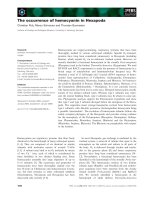

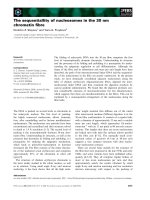
![Tài liệu Báo cáo khoa học: The stereochemistry of benzo[a]pyrene-2¢-deoxyguanosine adducts affects DNA methylation by SssI and HhaI DNA methyltransferases pptx](https://media.store123doc.com/images/document/14/br/gc/medium_Y97X8XlBli.jpg)
